This article was originally published on Political Film Blog on Jan. 12, 2014.
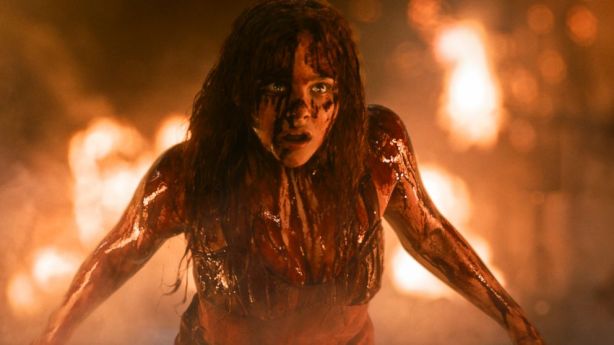
by Jennifer Epps
- Carrie (2013) is out on DVD this week.
When I heard that Kimberly Peirce was directing a new film version of the bullying horror flick Carrie, I thought it a safe bet that the bullying would go cyber (though Carrie herself would be out of the loop), that the gym teacher would have to eschew physical disciplining of the students, and that the high school might have more diversity. I predicted correctly, though none of these updates warranted remaking the movie. Peirce’s feminism, however, did suggest that she would steer Stephen King’s Cinderella story away from some of the most misogynistic excesses of Brian De Palma’s 1976 take on it, — and that was what seemed like a worthwhile endeavor.
The plight of misfit Carrie White and her coming-of-age has archetypal fairy tale resonance in De Palma’s prom-night movie, albeit complicated by De Palma’s typically icky ambivalence about women. (He would exhibit particularly nasty iconography against females in Body Double). The ‘wicked stepmother’ in this Cinderella tale is Carrie’s biological mother, but she feels just as threatened by the ingenue’s budding sexuality as the traditional matrons of these tales. Female peers (stepsisters in the Cinderella case, classmates in Carrie’s) also feel competitive with the heroine, and they do their best to undermine her; she feels she has no female network of support. Happily, a dashing and much-admired Prince Charming, normally out of range for this lowly, unsophisticated girl, discerns her merit; he sees past the cinders be-griming her features to her shining essence, as it were. These sorts of tropes, embraced for so long in fairy tales, began to be questioned and deplored by feminist critics in the 1970s – the same era that the novel and the movie emerged. In addition to transcending De Palma’s male-centric blinders, Peirce’s remake held the promise of re-examining the Cinderella archetypes behind it all with more psycho-social savvy.
Indeed, Peirce does emphasize girl-power, go easier on Mom, and show that despite competition the possibility of female friendship still exists. And she tries pretty hard to eschew the ‘male gaze’ that colored De Palma’s version. Gone is the prurient opening credit sequence in the locker-room, during which De Palma’s camera watched beautiful young women dress themselves (or not dress at all) in slow motion. The lyrical music and the way the actresses playfully thwacked each other with towels rather than cover up with them was jokey, of course, but it was like De Palma trying to make a Benny Hill skit seem intellectual. In a couple of other scenes, De Palma went in for close-ups of be-gowned Carrie and naughty-girl Chris’ nipples under their clothes (braless thanks to the seventies) but Peirce makes adolescent sexuality a central factor in her film without being voyeuristic about it.

Also gone: the prudish old-maid secretary glaring at Carrie disdainfully in the principal’s waiting room, Chris giving a parking-lot blow-job to her guy in order to get a favor in return, classmate Sue’s mental breakdown, and Sue’s mother drinking and watching soaps in the afternoons. Moreover, Sue is now a more central character, representing a kind of well-adjusted alternative to both Carrie’s fearful withdrawal and Chris’ defiant acting-out. (Peirce has stated that her aim was to adhere much more closely to King’s novel. Though Lawrence D. Cohen, who adapted King’s book for the original film, is also credited here for part of the screenplay, a new screenwriter, Roberto Aguirre-Sacasa, has been added to the mix.)
Peirce doesn’t laugh off the conflict between Chris and her boyfriend Billy like De Palma did. While in 1976 Nancy Allen and John Travolta played these scenes with great comic flair – revealing how petty and superficial their relationship was behind-the-scenes – De Palma also thought it was funny for Billy to slap Chris in the face, hard, on several occasions. Peirce, who took brutality against women very seriously indeed in her 1999 breakout debut Boys Don’t Cry, naturally sees it differently. So she presents Billy as egging Chris on, daring her — a dark character instead of a buffoon – and she implies that Billy is very capable of violence against Chris.
As a whole, the young men in the 2013 Carrie have more of an edge than the cut-ups in De Palma’s flick. This is a level not just in Billy (Alex Russell) but also in the star athlete and dream date Tommy (Ansel Elgort). His dialogue would make him seem to be upstanding and devoted, but he apparently doesn’t use protection with his girlfriend Sue (Gabriella Wilde), and he certainly doesn’t care much about romancing her first. There’s also a change in a minor character: the male English teacher is no longer an effeminate elf in a bow-tie, but a handsome hetero who makes eyes at a teenage girl in his class. Moreover, all Carrie’s female peers are now regularly, thoughtlessly, sexually active as a staple of high school culture. So though Carrie’s 1976 mom seemed to be spinning phantasmagorias of sexual danger out of thin air, it’s not that unrealistic for the 2013 parent to worry that Carrie might get impregnated in the back of someone’s car her first time out of the house. (The craziness lies in thinking that therefore Carrie must never have any kind of life whatsoever.)
The biggest difference between the two movies revolves around how Carrie’s lunatic mother Margaret White is understood. The role Piper Laurie had to play in 1976 – and in which she gave an admirable, theatrical performance – was devout with a capital D, and a woman-hater. She held fast to every scriptural anti-female reference she could find, and she apparently didn’t even believe in sex after marriage. Her twisted, fundamentalist Christian ideology (as extreme as if she had been reared in a private cult in a remote cabin) seemed to have scarred her from a very early age, and to have driven Carrie’s father away.
This was interesting in that it oppressed Carrie terribly, and when she rebelled against her mom she was also defying patriarchy. But De Palma’s film also suggested that it was only when Margaret is skewered with kitchen utensils that she can be sexual – pinioned by weapons from the knife rack, she panted and moaned as if in ecstasy. Visually, her pose echoed a spooky Saint Sebastian statue in Carrie’s prayer closet: the famous martyr shot with arrows, able to commune better with God because of it. Granted, the iconography of the bound, almost-nude Sebastian – much like that of the crucified Christ — does speak to a thread of psychosexual fascination with agony and ecstasy that lurks under historic Christianity. But in the real world, there are a lot more women who have to worry about other people confusing those two poles in their treatment of them than there are men who do. De Palma isn’t exactly serving society by putting that kind of imagery out there, however masterfully photographed and edited. (And it is masterfully photographed and edited, with a powerful score as well. Like Sam Peckinpah before him, De Palma’s very talent is a frustrating part of the problem; it makes the misogyny all the more compelling.)
By contrast, though Julianne Moore does play Margaret in the 2013 remake as a mentally ill person steeped in bizarre, oppressive dogma, she also loves her daughter in her own way. She is a little more functional too: she drives, she comes to school when called in. Though still a seamstress, she works at a dry cleaner’s rather than in her living-room, and she doesn’t dress in such a puritanical serge uniform and cape. (Moore looks conservative and prim in the movie, but not like a Salem witch-hunter, as Laurie did.) The production design even makes Margaret’s home decorating skills seem normal this time around – it’s kind of inexplicable, but Peirce doesn’t seem to want the Whites’ house to look like it’s in a horror movie. So unlike the house De Palma made into an eerie character of its own, this house is attractive and roomy; its yard and street are verdant and well-kept; the plain, freshly-painted walls are light-colored; the furniture is pleasantly arranged and ready for company; and judgmental male religious icons don’t surround the female inhabitants and glare down at them as they did in De Palma’s version.
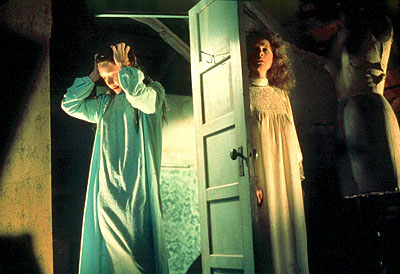
The extent to which Margaret hates herself is now more pitiful – and less funny-scary, the frequent quality of De Palma’s films (as Pauline Kael perceptively pointed out). Peirce’s movie digs deeper into Margaret’s self-hatred, and makes it quite serious. Whereas Margaret’s self-punishment was a passing idea in the 1976 film – and even seemed a little like she was putting it on for show in front of Carrie — here the miserable single mom is constantly engaged in self-harm. Any time Margaret is on-screen in this remake seems to invoke her secret addiction to self-mutilation and scarification.
In Aguirre-Sacasa’s screenplay update, it is much clearer that Margaret’s rigid hatred of sex was caused by a past rape, and Margaret is less of a monster and more a victim of traumas. Peirce’s film begins with a gripping prelude: blood-curdling screams and a slowly creeping camera find Margaret in the midst of labor, utterly alone, and at the same time completely unaware of how babies are made. She thinks she’s dying, not giving birth. This indelible image ensures that Margaret’s pathology will arouse some sympathy, and that we will keep that feeling for a good while.
On paper, such feminist angles seem like workable ideas. But a movie is not made of paper. There may have been problems with the story De Palma was telling, but he sure told it well; he has been a superb craftsman throughout his career. His Carrie is a prime example of how he can drive you crazy with suspense, contrast moods from scene to scene to scene, and take total charge of your emotions. Somehow, Peirce does a poor job at all of these essential things here — though she did them very well in Boys Don’t Cry. In cheesier territory than she was in for that debut drama or for her sophomore film Stop-Loss, she doesn’t seem to know how to handle tone. De Palma was adept at the balancing act; he could make a joke just in the way he moved the camera, never let you forget that you were watching a movie, and still scare you. In her own Carrie, Peirce doesn’t seem to know when she should be realistic and when she should be ridiculous, or which one she’s being at any one time.
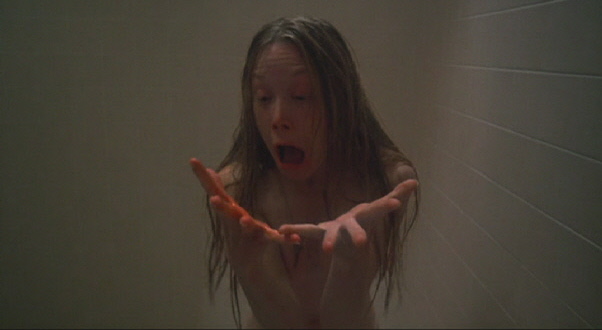
Sadly, the well-intentioned attempts to humanize Margaret with an opening backstory screw up the shape and tempo of the film. The prelude feels like grand opera, and it offers up blood in the very first scene so as to satisfy horror movie fans who can’t stand waiting till Act 3. But all that screaming and high drama come just two scenes before the flash-forward to Carrie, now-almost grown, has a pivotal scene when she gets her period in the high school shower – having no idea what’s happening, she assumes she’s mortally ill.
For Chloë Grace Moretz’s Carrie to momentarily worry that she’s internally bleeding is small potatoes compared to the terror and ignorance her mother went through. Carrie’s coming-of-age thus becomes less prominent a point in the story structure, her menstrual blood less potent as a symbol. Julianne Moore steals poor Chloë Grace Moretz’s thunder. And these imbalances soon take on a domino effect.
Moretz’s Carrie starts out fearful of her mother, and does get abused in an early scene, but it is not long before the girl appears quite able to distinguish current truth from the older generation’s delusions, and to stand up for herself — the emotional effects of living with her mother fade pretty easily. Sissy Spacek’s Carrie had a similar arc, but it seemed much more high stakes for her.
Furthermore, Moretz really does not play Carrie as much outside of it all as Spacek did. The new Carrie does figure out how to go online at school to look things up; she has much greater access to learning about the world. And she looks well-groomed from the very first scene — she doesn’t hide behind her hair as Spacek did, it even looks like she might be styling it before school. When Carrie’s getting ready for prom night, it hardly calls for much of a transformation – she already knows ‘how to clean up good’. One of the domino effects here is that because wallflower Carrie already looks pretty, and fairly comfortable (her eyes dart around fearfully but her overall body language is not that of a misfit), her peers have to be ten times more chic and model-perfect in order to leave her behind. Perhaps this is why Peirce seems to have cast the girls in the school from the same acting pool as Entourage.
In the age of ‘adorkable’, it’s harder to make us believe an asocial misfit really has nowhere to belong – nowadays we have to wonder if she couldn’t just go to Comic-Con and find her tribe. Or she could hang with the art students who always dress in black. Kids don’t seem limited to just two disparate camps anymore — complacently popular and hopelessly outcast – since Napoleon Dynamite, The Big Bang Theory, and even The Breakfast Club have intervened between the original Carrie and this update.
But instead of working harder to marginalize Carrie so we would believe she’s really at risk, Peirce seems to have wanted to normalize her so we would identify. Peirce doesn’t even seem to believe that telekinesis has a potential down side – this, in a movie about telekinetic mass murder. In the 1976 film, each telekinetic incident was accompanied by eerie Bernard Herrmann-like stabbing chords. This foreshadowed, however briefly each time, that Carrie might use the power for something ill. Peirce, however, treats Carrie’s discovery of her abilities like she’s Tobey Maguire learning how to shoot spider-webs from his palms. Carrie practices, mundane objects move courtesy of special effects, and Moretz reacts to it all with an astonished, open-mouthed stare. Try this at home, folks!
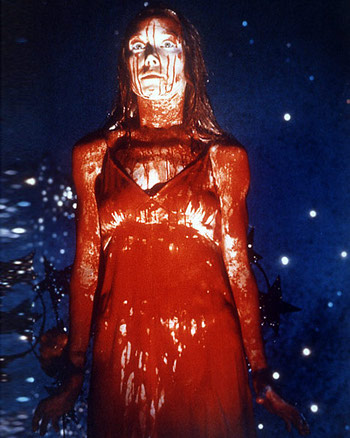
De Palma’s gliding camera moves and extended wordless montages stressed a kind of ironic hand of fate, making us actually feel some sadness over how noble intentions can still go astray. Even with his impish sense of humor, De Palma managed to make the climax of Carrie feel tragic. The remake doesn’t have that effect, even though the dialogue spells out repeatedly how much it wants our empathy.
In the original film, we couldn’t be sure what Sue intended in persuading her boyfriend Tommy to invite Carrie to the prom. For one thing, Amy Irving’s Sue had led the attack on Carrie in the shower –Wilde’s Sue in the new version doesn’t, and she comes down against the way Carrie is mistreated right away. The 1976 Sue seemed to be good friends with mean-girl Chris, their feuding was only hinted at – in 2013, it’s all laid bare. And in the original film, we never heard Sue’s conversations with Tommy play out; there was just enough to mislead us. Moreover, De Palma deliberately spliced Chris’ scheming scenes with Irving’s prom preparations – this cleverly made the two plans seemed linked.
Peirce, however, goes with King’s decision to sacrifice the ambiguity; there’s no doubt that Sue genuinely wants to help Carrie. And Peirce lets this part of the story go very slowly, with lots of dialogue between Sue and Tommy making plain their benevolence. (Yes, it’s disastrous to the pace as well as the credibility.) De Palma kept you constantly guessing about Sue and Tommy, and kept you so concerned for Carrie that you didn’t have time to really think about the plot contrivance. In fact, he kept Sue’s real feelings about Carrie muddy until the actual seconds before Carrie is doused in pig’s blood – and placing the revelation that Sue had meant well so late in the movie gave it a great impact.
Once you stop and think about what Sue is doing, however, it’s obviously ludicrous. If Sue wanted to help Carrie, she could just talk to her, not go behind her back and convince a football champion to escort her to the prom. She could share fashion magazines with Carrie, compliment her appearance, ask her about herself. Etc. If she wanted Carrie to feel more normal, surely the best way would be to include her, without any mystery, and thereby openly show her own peers that they should do the same. Peirce gives you way too much time to think about how silly the cornerstone of King’s plot actually is.
Consequently, Tommy and Carrie’s scenes in the remake are also remarkably banal. In the original movie, there were enough contradictions to be compelling: William Katt, 24 or so at the time he played the teenaged Tommy, had the maturity to highlight Tommy’s immaturity. Katt’s Tommy basks in the spotlight of being a golden boy. He is a plagiarist, not very interested in homework, and a giggler. He knows it’s cool to resent authority and if possible to outwit it, but he’s also a little afraid of his teachers’ power. Mostly, he wants to be ordinary, to conform. Because he liked being liked, Carrie’s suspicion of what he’s up to (she still doubts him even when they go to slow-dance) makes sense. We’re not sure he has the courage to befriend the pariah.
But in Peirce’s film, Tommy’s dialogue is on-the-nose, and Elgort portrays him as if teenagers have no immature thought processes. There isn’t, therefore, much space for him to grow, and the romanticism between Elgort’s Tommy and Moretz’s Carrie has no sparkle. (By contrast, when Katt danced with Spacek, De Palma filmed it in one single virtuoso 2-minute take from a tight low angle, with both the actors and the camera spinning around more and more vertiginously. It was romantic and alarming simultaneously – since the more Tommy seemed to fall for Carrie, the faster they rushed toward to their doom.) This time Elgort is just doing Moretz a nice favor, however, and Carrie’s fragility is barely an issue. The scenes between them at the prom are treated as if Sue’s scheme made perfect sense.
Having reserved his aces for the cinematically flamboyant sequences leading up to the prank pulled on Carrie, as well as the suspenseful stillness before her mother turns on her, De Palma was apparently the least interested of all in Carrie’s actual burst of revenge. He got it over with quickly, in a split-screen montage. He didn’t even clarify just what was going on, much of the time. (People die, vaguely, because of water hoses, electricity, and fire.) But Peirce is very interested in this section. She seems to have been rubbing her hands together, gleefully, anticipating it. She is vividly detailed about the ghoulish punishments Moretz inflicts on the students and staff at the prom, and takes her time making sure we understand exactly how each individual died. Peirce also has little sympathy for the victims, showing the whole room laughing at Carrie’s humiliating coronation — whereas De Palma suggested that only two or three people in the assembly were really laughing, and the rest were in Spacek’s head, planted there by her mother.
Though Spacek’s Carrie was in a daze, Moretz’s Carrie is lucid throughout her revenge, targeting individuals ruthlessly and sadistically. She also looks extremely commanding as she wreaks her havoc: no longer shy, this Carrie uses dramatic arm gestures as if casting spells, and she exudes a calm confidence for once. Carrie has become ‘cool.’ Also, have I mentioned she can now fly? Harry Potter, eat your heart out.
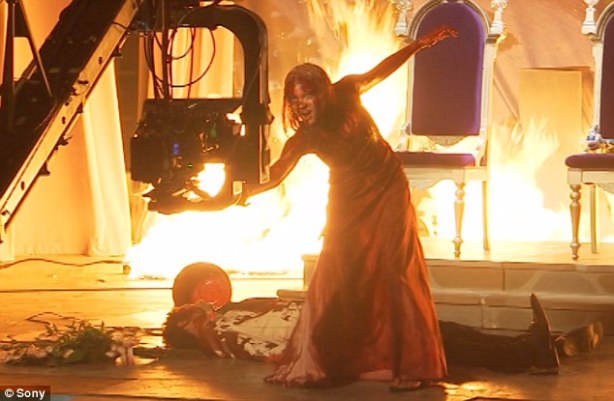
When Moretz’s Carrie leaves the site of the massacre, which she has just set ablaze, she hunts down the lead pranksters Chris and Billy and tries to kill them in their fleeing car by causing a miniature earthquake – it’s a remake, so I guess topping the spectacle factor of the original is a point of pride. However, it’s worth noting that in 1976, the order of events was the other way round: they tried to run her down, and she flipped their car over only in self-defense, thereby helping us retain a scrap of sympathy for Carrie. But Peirce doesn’t even end Carrie’s revenge with the car-flip. No, she drags this particular bit of gore out for a while, as Carrie dramatically tortures them before they die. Poor Carrie has no internet or TV, but apparently she’s up on horror trends.
This is not what one would have hoped for from Peirce. She created one of the most significant and searing films about bullying/non-conformity/intolerance one could ever hope to see in Boys Don’t Cry, the true story of hate-violence victim Brandon Teena. But with this film, it’s Carrie who becomes the bully. And apparently that’s supposed to be just fine – fun, in fact. Peirce has gotten stuck on trying to be one of the cool kids herself.
She might have really updated the movie by trying to bring a consciousness of Columbine, Virginia Tech, Aurora, Newtown, or the like into it. Instead, she made the kind of film that someone who feels like the underdog – someone like the loners who go out and perpetrate those kinds of massacres — can actually seize on and watch over and over again. Teenagers are already sorely tempted to see just about any slight they suffer as the gravest injustice, and to take their sense of being underappreciated deeply to heart. The film’s target audience is in fact the very same demographic which tends to go through a phase of self-importance; the same age cohort whose brains, science says, are still very much in the process of learning how to make objective judgments. So it’s fortunate that the protagonist of this movie is a girl, and that rampaging shooters tend to be male. But the fact that this new Carrie just won the People’s Choice Award for Favorite Horror Movie is still disquieting.

No comments:
Post a Comment